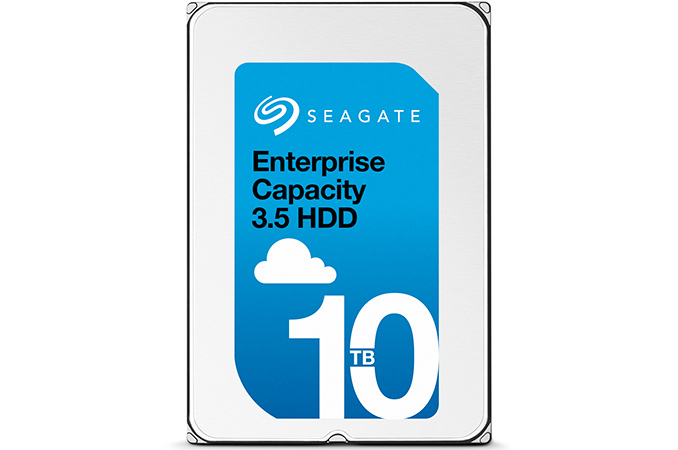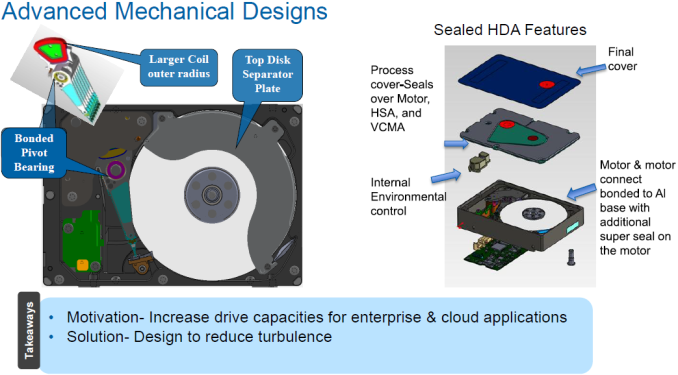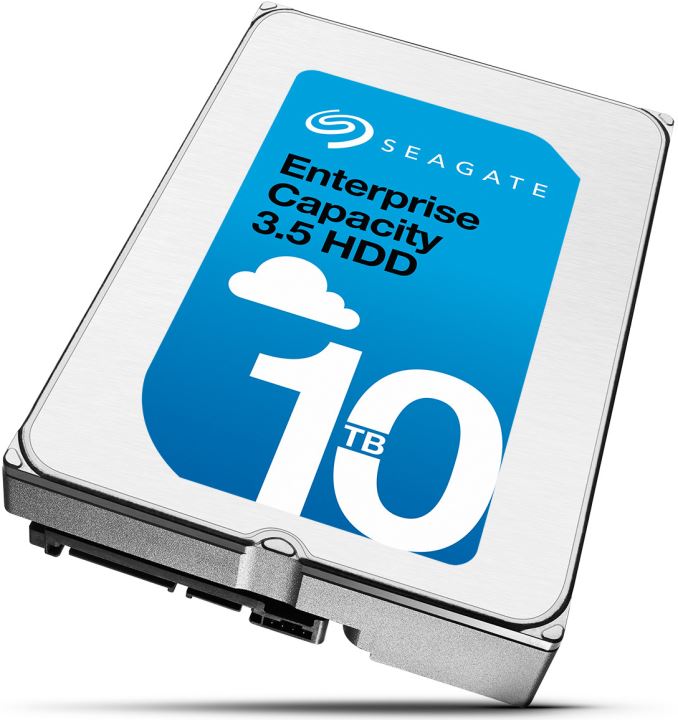Seagate Unveils 10 TB Helium-Filled Hard Disk Drive for Cloud Datacenters
by Anton Shilov on January 13, 2016 8:00 AM EST- Posted in
- HDDs
- Seagate
- PMR
- Helium HDD
- Enterprise Capacity
- 10 TB

Seagate Technology on Wednesday introduced its first helium-filled hard disk drive. The novelty is designed for cloud datacenters that require maximum amount of storage and enhanced reliability. By filling its HDDs with helium, Seagate can substantially increase their capacity and lower power consumption while using current magnetic recording technologies. At present, two major customers of the company are already evaluating the new hard drives. Volume shipments of the HDDs will start later.
The helium-filled Seagate Enterprise Capacity 3.5-inch HDD with 10 TB capacity incorporates seven perpendicular magnetic recording (PMR) platters with 1.43 TB capacity each as well as 14 heads. The manufacturer claims that the new drive features an advanced caching sub-system to increase performance. In addition, the new helium-filled Enterprise Capacity 3.5 HDD sports the company’s PowerChoice technology, which helps to manage power consumption during idle time, as well as PowerBalance technology, which enables operators of datacenters to balance power consumption and IOPS (input/output operations per second) performance of hard drives. Seagate claims 2.5 million hours MTBF for its helium-filled HDD, which is significantly higher compared to traditional enterprise-class drives.
Typically, Seagate’s Enterprise Capacity HDDs feature 7200 revolutions per minute (RPM) spindle speed as well as special top and bottom attached motors (in a bid to reduce vibration), but the manufacturer did not confirm such details about its 10 TB helium-filled hard disk drive. Since hermetically sealed HDDs feature significantly different internal architecture, many actual specs of the Seagate Enterprise Capacity 10 TB may differ from predecessors.
The new hermetically sealed helium-filled hard drives from Seagate use either Serial ATA-6 Gb/s or SAS-12 Gb/s interfaces and can be installed into various environments. The manufacturer did not reveal sector sizes of the new HDDs, but typically modern high-capacity hard drives have 4 KB sectors and can support 512-byte sectors via emulation. Typically, enterprise-class hard drives also optionally support data security features, such as self-encryption, secure erase and so on. Unfortunately, Seagate did not reveal exact feature-set of the helium-filled 10 TB HDDs, possibly because customers are only evaluating them at the moment and commercial drives may be different from today’s.
The density of helium is one-seventh that of air, which reduces drag force acting on the spinning disk stack and lowers fluid flow forces affecting the disks and the heads. By filling hard drives with helium, makers of HDDs can install up to seven platters into one industry-standard 3.5/1-inch hard drive, reduce power consumption of HDD motors and improve accuracy of arm’s positioning. All three benefits are crucial for modern datacenters.
By expanding capacity of its top-of-the-range Enterprise Capacity 3.5-inch HDD to 10 TB (up 2 TB from 8 TB, or by 25%), Seagate increases capacity per rack to 2400 TB (up from 1920 TB), which significantly bolsters storage density in a datacenter while decreasing power consumption per terabyte. For datacenter owners such changes reduce total cost of ownership (TCO) and help to maximize their storage capabilities without expanding area of their facilities.
Seagate said last year that it had experimented with helium-filled hard disk drives for about 12 years. While the company is several generations behind HGST with its hermetically sealed commercial HDDs, the company’s helium platform should be rather robust in terms of both reliability and performance.
At present, Alibaba and Huawei, who both said that the new hard drives help them to reduce their costs, evaluate Seagate’s Enterprise Capacity 10 TB HDDs. Some other companies have also received Seagate's new HDDs. HGST’s 10 TB helium-filled hard disk drives are already deployed by companies like Netflix, which need maximum amount of storage.
Seagate itself predicted recently that in 2016 its 8 TB hard drives would be its most popular high-capacity models. The company did not announce high-volume availability timeframe of its 10 TB HDDs, but it is unlikely that Seagate will ship a lot of such products this year. Pricing of Seagate’s Enterprise Capacity 10 TB HDD is unknown.
Mobile devices, Big Data analytics, 4K ultra-high-definition video, modern workloads and emerging devices generate tremendous amounts of data, which greatly increases storage requirements for datacenters. Since technologies like two-dimensional magnetic recording (TDMR) and heat-assisted magnetic recording (HAMR) are not ready for commercial hard drives just not, helium-filled HDDs will gradually gain importance for companies like Alibaba or Netflix. So far, HGST has shipped over four million helium-filled hard drives and in in the recent quarters adoption of such HDDs intensified among its customers.












40 Comments
View All Comments
PVG - Friday, January 15, 2016 - link
Nop. Helium, like hydrogen, is light enough to escape the atmosphere into outer space. Without constant dumping on the atmosphere from other sources, eventually there would be none to be distilled.SirMaster - Wednesday, January 13, 2016 - link
Well good thing HDDs like this use such a tiny amount of helium compared to say party balloons.zodiacfml - Wednesday, January 13, 2016 - link
I guess you have read it too. Anyway, I do agree it needs to be conserved as it should be left for more important or expensive purpose such as super cooling. Don't worry though, I'm confident that SSDs will be the choice of enterprises for its higher density (soon), performance, and reliability in the near future.HakkaH - Wednesday, January 13, 2016 - link
you should be way more concerned about fossil fuel than Helium. There is % wise an insane amount of helium more than there is any fossil fuel left even on the best estimates.The US helrium reserve had to be brought down (government rule) and infact the US supplies about 80% of the world helium us which just the US gathers. consider the amount then that is still left in the world. The way we are going right now we will probably destroy the polar ice caps faster than losing out on Helium.
nandnandnand - Wednesday, January 13, 2016 - link
there is no helium shortagehttps://archive.is/HVq1d
eldakka - Wednesday, January 13, 2016 - link
Worst comes to worst helium can be manufactured.Ways that we could 'manufacture' helium now (with sufficient funds):
1) Alpha radiation is helium atoms. Therefore generating high alpha-radiation sources can be used to 'farm' helium.
2) As helium is the second lightest element, it can, literally, be made by fissioning any of the heavier 100 elements that exist (might require successive fissioning of heavier to lighter, then fissioning those lighter elements etc).
Potential ways to manufacture helium that might be viable within the next ~50 years or so:
1) Fusion of hydrogen into helium. This of course assumes we ever get working fusion!
Potential ways to obtain helium that might be viable in the next ~100 years or so:
1) mining from the gas giants, most likely Saturn. Saturn's magnetic field and gravity are much, much less than Jupiters, therefore it is a more viable mining target than Jupiter. And, while the same is true to an even greater extent for Uranus and Neptune, they are much, much further away than Saturn. Also, Saturn has a moon, Titan, in orbit that has atmospheric pressure not too much different from earth's, while having less gravity, which would make it a good location for a base of operations (assuming it's not 100% automated).
CaedenV - Wednesday, January 13, 2016 - link
Holy cats! 2.4PB of storage per rack!I was perfectly content with the 7 3TB drive in my home server... not I feel that I need more even though I don't have a use for it... *yet*
eldakka - Wednesday, January 13, 2016 - link
mmmm, nice rack.3DoubleD - Wednesday, January 13, 2016 - link
I just thinking out loud here, but why do they fill the drive with He when they could just pump out the drive to a lower pressure? Both would reduce turbulance due to friction with the atmosphere. Perhaps building a case capable of widthstanding the pressure differential is much more expensive than a case that can remain hermetically sealed for the lifetime of the drive? Perhaps an atmosphere is needed for convection of heat? Again, just wondering out loud. If anyone knows the answer go ahead and jump in.Guspaz - Wednesday, January 13, 2016 - link
Hard drives don't work in a vacuum, the read/write head need a cushion of gas to keep the head from hitting the platter.